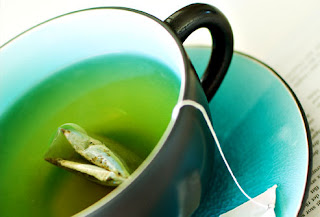The sun is shining, temperatures are rising. Summer is the time to shed layers of clothes, as well as some pounds. You could opt for a stringent diet regime, but what about simply enjoying all the wonderful foods the season brings? You'll still slim down, and do wonders for your health.
It's a natural trend to eat lighter during the summer, and you can easily do so without feeling deprived. If you follow the U.S. government's 2005 dietary guidelines of four-and-a-half cups of fruits and vegetables and three servings of fat-free or low-fat dairy each day, you'll be getting plenty of naturally low-cal foods that are high in fiber, calcium, and important nutrients.
"Fiber helps in weight control because it promotes a feeling of satisfaction or satiety," explains Registered Dietitian Cheryl Orlansky, of the Computer Science Corporation. "High-fiber foods, eaten consistently, prevent that rebound effect of feeling full one minute and looking for something else to eat the next. It also helps modulate blood sugars by slowing down the digestion of sugars to prevent a quick surge into the bloodstream."
Much of summer's bounty has extra nutritional benefits you may not be aware of. Fruits and vegetables contain antioxidants and other phytonutrients that may slow aging, protect against cancer and stroke, improve blood pressure, and keep your heart healthy. And just about all are low-calorie, so your waistline stays in check, another big health benefit.
Ready to slim down with summer foods? Start your summer "diet" with these:
Tomatoes and Peppers for Vitamin A, Vitamin C, and Lycopene
These powerhouses of nutrition are members of the fruit family, though thought of mostly as vegetables. Tomatoes and bell peppers of all colors deliver large amounts of vitamins A and C. A medium tomato, for example, is low in carbohydrates and has only has 35 calories but gives you 40% of the vitamin C and 20% of the vitamin A you need for the day.
Tomatoes have other benefits, too. "Consuming a diet rich in tomatoes has been shown to decrease the risk of prostate and other digestive tract cancer," says Emily Abercrombie, RD, LD, a clinical nutritionist at Atlanta's Emory Hospitals. This is because tomatoes and processed tomato products have high levels of a nutrient called lycopene, a powerful antioxidant that gives some fruits and vegetables their color.
Lycopene may prevent as well as treat several types of cancer. Research suggests it also may help prevent the LDL "bad" cholesterol in the bloodstream from being converted to oxidized LDL that can form plaques in arteries and increase the risk of heart attacks.
Peppers have antioxidants too, such as beta carotene, which can help boost the immune system and prevent the cell damage that comes from free radicals, a natural byproduct of our bodies' normal functioning. Studies show damaged cells can lead to a number of diseases, such as cancer and heart disease.
Peppers also have plenty of vitamin C, even more than tomatoes. Just a half cup of the green, yellow, or red varieties have more than 230% of your daily vitamin C requirement. Keep some pepper strips on hand for a tasty calorie-controlled snack. A half cup of fresh peppers has only 20 calories.
Nothing says summer like the colorful array of berries that start showing up in your produce section at the grocery store. Strawberries, raspberries, blueberries, and blackberries satisfy your sweet tooth and are rich in nutritional bonuses, such as vitamin C. Strawberries have the most vitamin C of any member of the berry family.
Andrea Dunn, RD, LD, of The Cleveland Clinic, says, "Berries are rich in a substance called ellagic acid, which acts as an antioxidant, helps the body deactivate specific carcinogens, and slows the reproduction of cancer cells. Berries may also help prevent urinary tract infections."
Abercrombie adds, "Berries are a good source of fiber, which in turn help in lowering cholesterol." She also notes that studies with blueberries show they can help improve memory.
Berries in general are convenient to eat, tasty, and easily eaten by themselves or mixed with yogurt for smoothies. Their per-serving calorie count can be as low as 45 calories. You can cook them, too, though that tends to break down the antioxidants. A "cool" way to preserve them? Pop them into the freezer, and eat them frozen for a refreshing snack.
Yogurt for Calcium and Protein
Not so long ago, yogurt was considered something only health food junkies ate. Now, it is a dietary staple for many who enjoy the taste, convenience, low calories, and, yes, health benefits.
Yogurt can even help you slim down, according to recent studies showing a low-calorie diet that includes three servings of dairy a day can help promote weight loss. Orlansky says yogurt is very appealing to those wanting to lose weight because of the protein/carbohydrate combination it offers.
"These nutrient combinations can help stave off hunger," she explains, adding that, "Yogurt contains about 30% of the recommended daily value in calcium and should be added to the diet since most American adults are not drinking milk."
Yogurt is made by curdling milk with purified cultures. That means that in addition to protein and calcium, it is high in live active organisms called probiotics. These can boost your immunity, prevent yeast infections, and keep your gastrointestinal tract healthy.
Flavored, plain, or low fat, you can eat yogurt as a snack or as the protein source at a meal. Yogurts make a great dip for fruits and vegetables and a delicious dessert topping instead of ice cream. For the best of smart and tasty eating, combine low-fat yogurt and fresh berries for a summer smoothie.
Protein- and Fiber-Packed Beans
The benefits of beans or legumes are as wide as the varieties available. Peas, lentils, black beans, butter beans, lima beans, garbanzo beans (also called chickpeas) -- and that's a very short list. All are nutrient-rich and great sources of fiber, iron, and protein.
These small, tasty treasures can help you feel full longer, while curbing your appetite for foods that are high in fat. They have little or no fat themselves and are usually inexpensive as well. Most are good raw and can be easily mixed with other foods to add flavor, substance, and color.
"Substituting beans for animal protein in a meal can lower calories, saturated fat, and provide zero cholesterol," says Orlansky. She adds they are "particularly high in soluble fiber, which helps blood cholesterol levels."
Cleveland Clinic dietitian Andrea Dunn also notes that most beans are an excellent source of folate. Adequate amounts of folate may help keep the heart strong and are important for expectant moms, since studies show folate helps reduce certain birth defects in a growing baby.
The calorie count for a 4-ounce serving of beans ranges from about 65 calories for frozen peas to 115 for boiled black-eyed peas. The highest count, with just 160 calories, goes to Borlotti beans.
"Time to tango with the mango," Dunn says of this not-well-known summer treat. Mangoes have been a staple of people's diets in Southeast Asia and India for more than 4,000 years.
Mangoes have some big advantages over other fruits. They contain more fiber than most, which helps you curb your appetite. They are low in calories (about 95 for a medium fruit), fat, and sodium, contain no cholesterol, and have more beta carotene than any other fruit.
"Not only a source of one-fourth your vitamin A for the day, the mango is also a great source of vitamin C," Dunn explains, adding that it provides about 76% of your daily vitamin C needs in just one cup and is a nice alternative to oranges.
Mangoes are also high in carotenoids (like beta carotene) and bioflavanoids. These powerful antioxidants are good for a healthy immune system and help repair the cell damage that can lead to disease, such as cancer.
Potassium is another benefit of eating mangoes, which are loaded with this important mineral. Your body needs potassium to help regulate blood pressure and heartbeat, but many people don't get enough.
Last but Not Least, Wonderful Water
Probably the most important "food" of any diet is water. In fact, it's essential. It may have no nutritional value, but it is a catalyst for a majority of bodily functions, including digestion, metabolism, and cell function.
Water is also key for helping those trying to lose weight. It curbs hunger pains, especially when it's included in foods such as fresh vegetables and fruits.
"Research has shown that water-containing foods like fruits and vegetables and soups are encouraged for weight control because of the water," Orlansky says. "The water increases the volume of the food and lowers the amount of calories." Another reason water helps with weight loss is that if you don't get enough water, your body will try to hold on to what it has so it can continue to operate. This will leave you bloated and the only way to get rid of the excess water is to take in more water.
The adult human body is 60% water and on average, loses about one cup or 8 ounces per day from normal activity. On the upside, a typical daily diet includes about four cups of water in the food you digest. Still, nutritionists advise drinking eight glasses of water daily to keep your body functioning like a well-oiled, or hydrated, machine.
































































